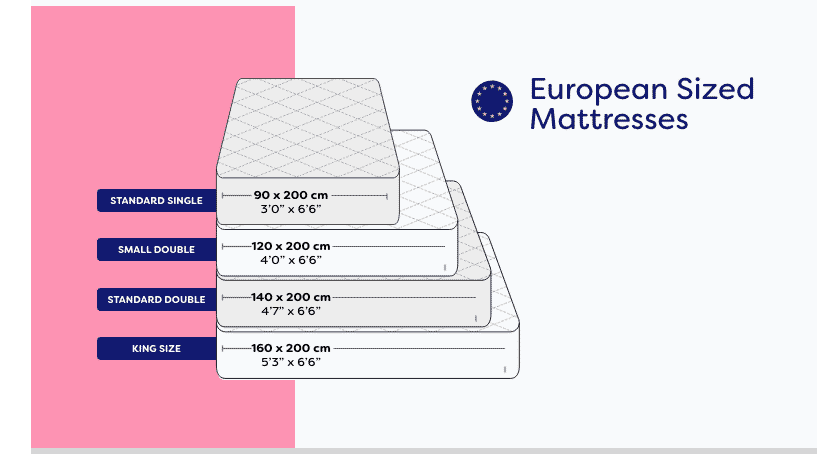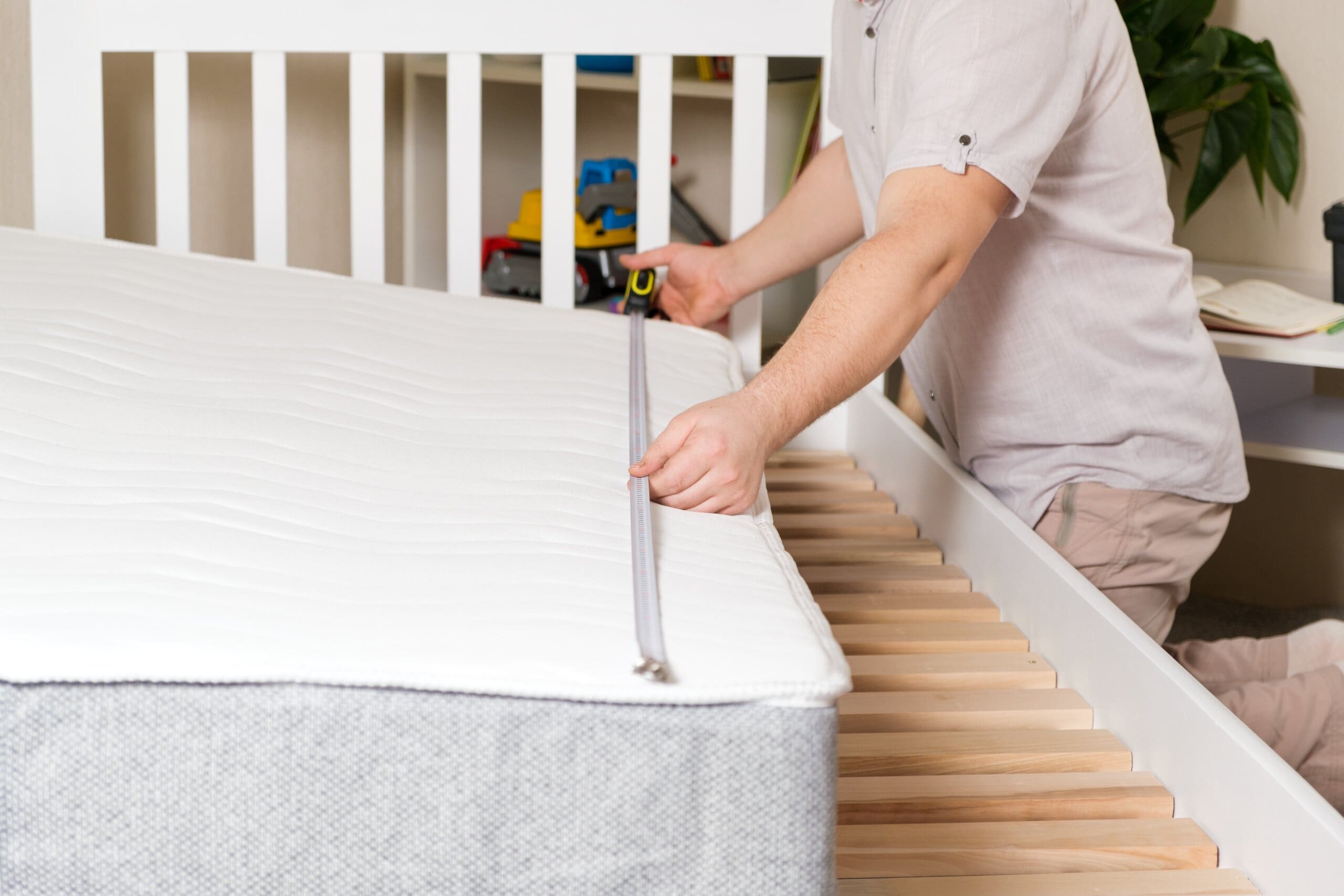Ultimate Uk Bed & Mattress Size Guide
Discover everything you need to know about mattress and bed sizes and dimensions, ranging from small single to super king size; as well as tips on how to measure up.
The size of your bed and mattress requires serious consideration - not only should you think about how much room you want to stretch out, but also who else is sharing the bed with you, whether that's a partner, children or even pets.
To ensure you make the right decision, we’ve compiled a mattress size guide that provides all the information you need. We've covered everything from the basic measurements of each mattress type, to the benefits of certain sizes and measuring considerations.
We’ve also helpfully included both metric and imperial bed and mattress measurements, as well as answered your most frequently asked questions surrounding bed and mattress sizes in this helpful bed size guide.
UK bed & mattress sizes
Simple but effective, here's the basic dimensions of UK beds and mattresses:

| Bed/Mattress Size | Dimensions (Metric - CM) | Dimensions (Imperial - Feet & Inches) |
| Small Single | 75 x 190 cm | 2’6” x 6’3” |
| Standard Single | 90 x 190 cm | 3’0” x 6’3” |
| Small Double | 120 x 190 cm | 4’0” x 6’3” |
| Standard Double | 135 x 190 cm | 4’6” x 6’3” |
| King Size | 150 x 200 cm | 5’0” x 6’6” |
| Super King Size | 180 x 200 cm | 6’0” x 6’6” |
We also offer children's size mattresses, such as cot and cot bed mattresses, which measure as follows:
| Cot Mattresses | 120 x 60cm or 47" x 23" |
| Cot Bed Mattresses | 140 x 70cm or 55" x 27" |
For more information, as well as the difference between cot and cot bed mattresses, read our Ultimate Guide to Kid’s Bed Sizes.
Is bed size the same as mattress size?
In the UK, bed frame measurements directly correspond to the same mattress size. So, a small double bed frame will have the same dimensions as a small double mattress. That’s why in this guide we use the terms ‘bed’ and ‘mattress’ interchangeably.
However, it’s important to note that if you want to know exactly what size bed you can fit in your room, you should take a look at individual bed frame dimensions, as they can differ between manufacturers or design.
Which is the best bed and mattress size for me?
The best bed and mattress size for you will depend on a wide range of factors, including whether you sleep alone or with a partner, your size, any health conditions (such as back problems), how much space you have, and what your budget is.
To help you make a good choice, we’ve provided a brief explanation of the dimensions and benefits of each of the main mattress sizes. All of the measurements used in this section are based on UK standards, though you can also find European (Ikea) and US measurements lower down the page.
Once you know what size mattress you need, you can take a look at our Mattress Buying Guide for tips on how to choose the right mattress type for you.

What size is a small single bed/mattress?
Small single mattresses measure 75 x 190cm or 2’6” x 6’3”.
Small single mattresses are usually the smallest on the market, apart from cots and designs orientated towards babies. Younger children often prefer the cosier feel of a small single, so they’re a popular choice for kids who are just starting to sleep alone.
Of course, they’re also made for smaller bedrooms or those instances in which you need to fit more than one bed in a room. Sometimes bunk beds simply aren’t a practical choice, so small singles allow you to put two kids into a bedroom without compromising too much of the floor space. However, ensure you measure bed size and room size before making your decision.
Best for: children and small bedrooms with multiple beds.
What size is a single bed/mattress?
Standard single mattresses measure 90 x 190cm or 3’0” x 6’3”.
The standard single mattress size may seem small when compared to doubles and king-size beds, but there’s still enough space for a fantastic night’s sleep. Standard singles are typically chosen for box rooms, guest rooms, and any bedrooms where floor space is prized more than sleeping space.
They’re also well suited to children’s bedrooms, particularly younger kids without big, open beds. They’ll provide you with years of comfort, and good models are built to last, so they’re a wonderful investment if you’re happy with the relatively small dimensions.
Best for: children and teenagers.
What size is a small double bed/mattress?
Small double mattresses measure 120 x 190cm or 4’0” x 6’3”.
The small double is the standard double’s versatile, space-saving, smaller sibling. It’s designed for rooms that are shorter on space and will fit in most master bedrooms and spare rooms. If you’re a couple, you’ll be sleeping closer together, but there’s still plenty of room - as long as neither of you are nocturnal fidgeters.
It’s a good choice if you’re worried that larger models will leave you without any space to move around the bedroom. The small double bed and mattress is also often found in growing kids and teenagers’ rooms, especially where there isn’t enough room for the size of a double bed. It’s a perfect intermediary stage between the classic single and a larger double or king size, allowing you to stretch out and make yourself comfortable, without dangling off the edges.
Best for: teenagers, single sleepers and couples who like to cuddle up.
What size is a double bed/mattress?
Standard double bed size UK measures 135 x 190cm or 4'6" x 6'3".
A standard double bed is the most popular bed and mattress size in the UK. This is largely down to the fact that it fits in most bedrooms and offers a significant amount of sleeping space. This makes it a great choice if you’re concerned with over-cluttering or would like to add more furniture to the bedroom.
The standard double mattress size is also regularly found in guest rooms, which are generally a little smaller than master bedrooms. As they’re used less regularly, beds in guest rooms don’t need to be as large. However, they’ve still got to be comfortable, so a double bed size strikes this balance perfectly.
Best for: couples and guest rooms.
What size is a king-size bed/mattress?
King-size mattresses measure 150 x 200cm or 5'0" x 6'6".
King-size mattresses are a perfect compromise if you’re looking for a large amount of sleeping space but can’t quite fit a super king-size in the bedroom. They’re spacious and ideal if you’re on the tall side or share the bed with a partner. The extra legroom will let you stretch out and get comfy - which is absolutely essential for a good night’s sleep.
Many people struggle to decide between a king size or standard double. We reckon it’s a pretty simple choice. If your bedroom is big enough for UK king size bed dimensions, the extra space it offers is definitely worth it. The extra 10cm in length and 15cm in width may not sound like a lot, but it makes an enormous difference to your night’s sleep.
Best for: couples that want added sleep space but don’t have the room for a super king.
What size is a super king bed/mattress?
Super king mattresses measure 180 x 200cm or 6'0" x 6'6".
If having plenty of sleeping space is the most important factor in your decision, a super king-size bed is the way to go. The dimensions of a super king allow you to really spread out, and this bed is ideal if you’re a couple who value having enough room to wriggle and move about without impacting on your partner’s sleep.
If you’re considering a UK super king-size mattress, you need to be aware that you’ll need plenty of floor space, particularly if you want to fit in furniture around it. This is the biggest bed size type available in most cases, and its large size means it makes quite an impact on how your bedroom looks!
Best for: those who want the ultimate in terms of sprawl-out space, or often have kids and pets join them in bed.
What size is a queen size bed/mattress?
Queen size is a confusing term as it’s not fully defined – some people, particularly those in the UK, say that a queen-size mattress is the same as a small double. In the US, however, a queen-size mattress may refer to a ‘California Queen’, which measures 152 x 203.5cm – as large as a UK king.
If you’re a UK buyer looking for a queen size mattress, envisioning a bed that’s slightly smaller than a double, then take a look at our small double mattresses. If you’re thinking of the American ‘California Queen’, we’d recommend looking at our super king size mattresses.
Best for: UK buyers looking for a small double.
European bed & mattress sizes (IKEA bed & mattress sizes)

| Bed/Mattress Size | Dimensions (Metric) | Dimensions (Imperial) |
| EU Standard Single | 90 x 200cm | 3'0" x 6'6" |
| EU Small Double | 120 x 200cm | 4'0" x 6'6" |
| EU Standard Double | 140 x 200cm | 4'7" x 6'6" |
| EU King Size | 160 x 200cm | 5'3" x 6'6" |
The main difference between European and UK sizes is that European sizing is slightly longer in length. A standard single, for example, is 90cm in width like the UK version but boasts a 10cm length advantage at 200cm.
At MattressNextDay we offer a range of European sized mattresses, so if you've recently purchased an IKEA bed or bed from overseas, you can find a perfectly fitted mattress. A Euro king size mattress is the perfect choice for couples who want that extra bit of room to stretch out, without going for a UK super king. A Euro double, similarly, is best for couples who often have pets join them in bed, or can't fit a UK king size in their bedroom.
USA American-sized mattresses

| Bed/Mattress Size | Dimensions (Metric) | Dimensions (Imperial) |
| Twin | 96.5 x 188.0cm | 3’2” x 6’2” |
| Twin XL | 96.5 x 203.5cm | 3’2” x 7’0” |
| Full | 134.5 x 190.5cm | 4’5” x 6”2 |
| California Queen | 152 x 203.5cm | 5’0” x 7’0” |
| California King | 183 x 213.5cm | 6’0” x 7’0” |
| USA King | 193 x 203.5cm | 6’3” x 6’6” |
American beds are far larger than their UK counterparts – the USA’s standard king size is larger than a UK super king. There are no real direct translations between UK and US sizing, as US beds tend to be wider or longer, or a combination of both. However, you can use our handy table to envision the dimensions of a USA size mattress. Keep in mind that American mattresses will be too big for standard UK bed frames, so ensure your mattress and bed frame measure up properly.
How to find your perfect bed size
Accurate measurement is key if you want the right size bed and mattress. We’d recommend double-measuring everything to ensure you’ve got it right. Below, we cover a few essential sizing considerations when buying a new bed or mattress.
1. Choosing the right bed size for your body size
The most important thing when choosing between bed sizes is that you find a model that’s right for you. After all, there’s no point in having a mattress that you aren’t comfortable sleeping in! As a general rule of thumb, you want a bed that is at least 10cm longer than the height of the tallest person using it.
You also want to make sure that the mattress is wide enough. To do so, lie on your side and tuck your hands on your head, so your elbows stick out in front of your chest. If your elbows reach the edge of the mattress or touch your partner, you may want to think about a larger bed.
2. Choosing the right bed size for your room
It’s important to remember that your bed isn’t the only thing in your bedroom. That means you need to make sure there’s space for any additional furniture and for you to move around without bashing your shins on the corner of the bed! Think about how much space you need, measure it, and then work out what’s left for the bed.
Remember to consider the way wardrobe doors open and make sure you think about the smaller details, such as where plug sockets are located and how the size and positioning of the bed will affect their use.
3. Choosing the right mattress size for your bed
While bed frames are usually designed to match up with a specific mattress size (e.g., a standard double frame for a standard double mattress), there is some variation. Design features like headboards and footboards can influence the mattress sizes you’ll be able to use, so it’s always a good idea to measure first.
Keep in mind that bed frames might be slightly larger than your mattress to allow for a perfect fit, so do look up the accurate dimensions of your bed frame to ensure it fits properly in your room. You don't want to bash your shins!
How to measure your bed
To measure your bed size properly, measure from the very bottom of the bed frame to the very top - making sure you measure to the outsides of the frame. This will give you the accurate length of the bed, and you can measure from side to side from the width. It will also be worth measuring the height of your bed - from the floor to the highest point of the base - as you will need to add this to your mattress depth for the total height of the bed.
How to measure your mattress
Using a tape measure, you should measure from top to bottom for the length of the mattress, and side to side for the width. Measure from seam to seam, as this will provide the most accurate measurement. It will be helpful for you to know the depth of your mattress, as this will help with both understanding how tall your bed will be in total, and help when purchasing fitted sheets. For mattresses over 35cm thick, you may need extra deep fitted sheets.

How to measure your room to see which size bed will fit
How can you know which size bed will fit better in your room? Here’s a rough guide to measuring your room for a new bed.
- Calculate the area of the room by measuring the length and width.
- Draw a scaled diagram of the room.
- Using the diagram, explore the positioning of the bed – remember to use the size of the bed frame and not just the mattress here.
- Keep in mind that doors will need space to open, including wardrobe doors.
- Assess the position of current furniture and potential protrusion – are there drawers you will need access to?
- Allow for at least two feet of space between the foot of the bed and the wall for passing.
Drawing a diagram of your room might seem like an additional step, but it’s a really helpful way to ensure all furniture fits within the confines of the room, and you have space for doors and drawers to open. If you have space for a king-size bed, then the benefits are fantastic. But if you lose space elsewhere, then this might outweigh the upsides of a bigger sleeping space.
If you're looking for a divan bed, consider how much room you'll need to open the drawers on either side. You should leave at least 60cm either side of your bed in order to be able open and access them properly. Read our Divan Bed Buying Guide for more advice.
60cm is also a good amount of space to leave between your bed and the wall, as this will give you enough room to move around the bed. You'll need at least 55cm at the foot of your bed, too.
What width should my bed be?
Most couples still have a standard double bed, which measures 4’6” wide (135cm). For two people, that can be quite a tight squeeze, not giving either partner much room to get comfortable or stretch out. Split a standard double mattress in half and you have just 67½cm each to sleep on!
That could be considered ‘cosy’ at best and if you love snuggling up with your partner, that’s great. However, if you want a little more space then a larger bed may be a better option. A king mattress is 5 feet or 150cm wide, while a super king is 6 feet or 180cm wide.

For single beds, take into account the age of the person using the bed. If it’s for a young child then a small single at 2’6” or 75cm will be sufficient.
If the bed is for a growing teenager, we suggest moving up a size to a single at 3 feet (90cm) wide or even a small double bed and mattress at 4 feet (120cm) wide.
What length should my bed be?
Your bed should be 10cm longer than the tallest person in the bed to stop the dreaded ‘overhang’ at the bottom (which can result in cold feet or uncomfortable gaps in the duvet at the bottom of the bed). A standard UK double bed is only 6ft 3” or 190cm, so if you’re over 5ft 11” you might want to choose a longer king size or super king size bed at 6ft 6” or 200cm long.
Other things to consider when choosing your bed size
Do you want space on either side of the bed?
If you’re a couple, you probably both have your own nightstand or table with a lamp, and your own areas within the bedroom. Make sure that your base ‘footprint’ leaves you both enough room on either side. If you’re adding a single bed to a small room, the most likely position is with the bed pushed up against a wall. Therefore, access to both sides of the bed isn’t as important.
Are you or your partner particularly tall?
There’s nothing worse than a mattress that’s too short. You’re left with your feet hanging over the ends and it’s difficult to get comfortable. If you or your partner are over six foot tall, it may be worth going up a size (if you have the room) so that you don’t have to scrunch up to fit.
Knowing what bed sizes are available and how to measure your room correctly will save you from encountering problems later down the line.
Double Vs. King Size Mattress
Double and king-size are two of the most common universal mattress sizes that people purchase. Depending on your space, layout, budget and personal preferences, one may be more suitable for you than the other.
One of the first things to consider when buying a mattress is the dimensions. A double room may have space for a king-size bed, but it’s also possible that this would limit floor space. So, if you are not sure which to pick, take a look at the below dimensions and measure your space accordingly.
| Mattress Type | Dimensions |
| Double | 135 x 190cm or 4’6” x 6’3” |
| King-size | 150 x 200cm or 5’ x 6’6” |
While it’s obvious that a king-size mattress is wider than a double, many people don’t realise that it is also three inches longer. This might not seem like a significant size difference, but if you have a small or unusually shaped room, then you’ll need to keep this in mind when working out what fits best.
If you’re a tall person or you simply like to stretch out in bed, then this extra length could be what seals the deal for a king-size mattress. Remember, when measuring a space, it’s not just the dimensions of the mattress you’ll need to consider, but also the bed frame and headboard.
Pros of a double mattress:
- Fits in most bedrooms, even smaller ones
- Offers comfort and flexibility for visitors to your spare room
- Spacious enough for two adults
- A decent upgrade for a new teenager who wants a more grown-up room
- Universal-sized bedding available in most shops
Pros of a king-size mattress:
- Good length for tall people
- Space for pets or children who may pay you a visit in bed
- Only requires a few inches of extra space each side
- Universal-sized bedding available in most shops
Of course, if you want an even bigger sleeping space, you can opt for a super king size bed - which is a whopping 6 feet wide - giving you optimal room for you, your partner, and any pets or children that may join you.
What are zip and link mattresses?
Zip and link mattresses are two smaller mattresses that zip together to form a large king or super king mattress. Zip and link mattresses are designed to offer personalised sleeping areas, so you feel like you're sleeping in a bed on your own, but you're still next to your partner. This type of mattress is ideal if you or your partner tend to toss and turn in the night, as you won't be disturbed by each other.

Let us make your decision easier
When choosing your mattress and bed frame size, you should consider how easily you can manage getting it up the stairs or into your desired room. Luckily, we offer a Room of Choice service, where our helpful delivery drivers will take your order up to your bedroom for you.
We also offer a Mattress Recycling service, so we can take away your old mattress as we deliver the new one. Both of these services are available to add at check out.
Bed size tends to correlate with weight, too, with some larger mattresses naturally being heavier than smaller ones. This is worth considering not just for delivery and assembly, but also for regular maintenance, where you should flip or turn the mattress every few months.
But don’t worry - we have a huge range of no-turn mattresses that require very little maintenance, such as many of our memory foam mattresses. If you're interested in memory foam mattresses and want to know more, take a look at our Memory Foam Mattress Buying Guide.
FAQs
Not quite found the answer you're looking for? No worries, take a look at our frequently asked questions. If you're still struggling, feel free to contact our customer service team via live chat or the form on our Contact page - they will be happy to help with any query.









